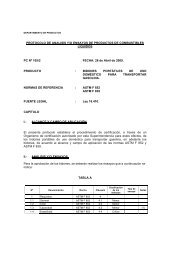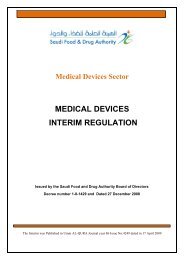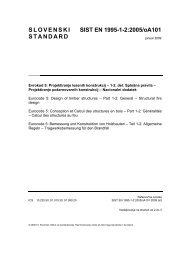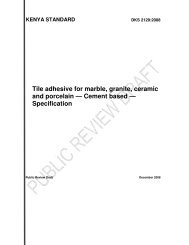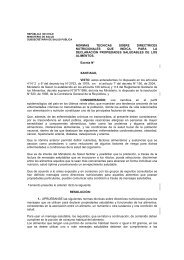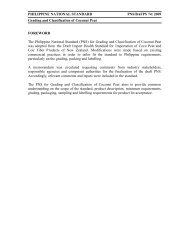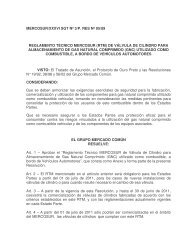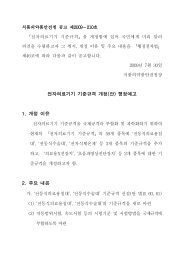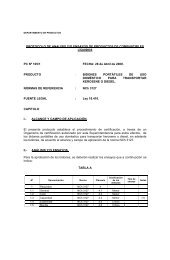Pakistan Standard specification For Apple juice
Pakistan Standard specification For Apple juice
Pakistan Standard specification For Apple juice
Create successful ePaper yourself
Turn your PDF publications into a flip-book with our unique Google optimized e-Paper software.
PS: 1739 - 1985<br />
0. FOREWORD<br />
<strong>Pakistan</strong> <strong>Standard</strong> <strong>specification</strong><br />
<strong>For</strong><br />
<strong>Apple</strong> <strong>juice</strong><br />
0.1 This <strong>Pakistan</strong> <strong>Standard</strong> was adopted by the <strong>Pakistan</strong> <strong>Standard</strong>s Institution on<br />
21 st November, 2008 after the draft finalized by the Fruit and Vegetable<br />
Products Sectional Committee had been approved by the Agriculture and<br />
Food Products Division Council.<br />
0.2 <strong>Apple</strong> <strong>juice</strong> occupies an important place among the fruit <strong>juice</strong>s manufactured<br />
in the country. It is, necessary to ensure the quality of fruit <strong>juice</strong> if the<br />
demand is to be maintained and further developed. In order to ensure<br />
maintenance of proper quality it is necessary to have strict quality control<br />
based on <strong>specification</strong>s. Need was, therefore, felt to formulate <strong>Pakistan</strong><br />
<strong>Standard</strong> on apple <strong>juice</strong>.<br />
0.3 In the preparation of this standard considerable assistance has been derived<br />
from the IS: 7732 – 1975 for <strong>Apple</strong> Juice. The assistance so derived is<br />
acknowledged with thanks.<br />
0.4 In the preparation of the <strong>Apple</strong> Juice, after expression in the reamer the <strong>juice</strong><br />
will be strained, flash pasteurized and then filled into suitable containers<br />
bottles, thins, cardboard containers and tetrapacks. Added sugar is permitted<br />
in order to prepare a product of pleasant taste.<br />
The process of expression and filling is so conducted so that there is a<br />
minimum loss of vitamin C in the finished product. Addition of liquid<br />
glucose and potassium phosphate is also permitted, if declared on the label.<br />
0.5 PS: 630 – 1967 Method of sampling and test for Fruit and Vegetable Products<br />
is a necessary adjunct to this <strong>Standard</strong>, for reference to the method of<br />
sampling and <strong>Standard</strong>.<br />
0.6 <strong>For</strong> the purpose of deciding whether a particular requirement of this standard<br />
has been complied with, the final value observed or calculated expressing the<br />
result if a test or analysis shall be rounded off in accordance with PS: 103 –<br />
1960. Method of rounding off Numerical values, the number of significant<br />
places retained in the rounded off value shall be the same as that of the<br />
specified value in the standard.<br />
1. Scope
PS: 1739 - 1985<br />
1.1 This standard prescribes the requirements and methods of sampling and test<br />
for apple <strong>juice</strong> preserved exclusively by physical means. The <strong>juice</strong> shall be<br />
obtained from apples.<br />
2. TERMINOLOGY<br />
2.0 <strong>For</strong> the purpose of this standard, the following definition shall apply.<br />
2.1 Absence of Defects:― Freedom from particles of membrane, core, skin, seed<br />
and foreign material, such as grit and dirt, and also freedom from coarse<br />
particles of pulp.<br />
3. REQUIREMENTS<br />
3.1 General:― <strong>Apple</strong> Juice be obtained by a mechanical process from sound,<br />
mature apples or by reconstituting concentrated apple <strong>juice</strong>. The Juice shall<br />
have characteristic colour, taste and flavour. It may be turbid or clear. The<br />
<strong>juice</strong> and flavour. It may be turbid or clear. The <strong>juice</strong> shall not show any<br />
signs of fermentation. It should be free from pathogenic micro organisms.<br />
3.2 Food Additives<br />
3.2.1 Ascorbic Acid – 50mg / 100ml (min.)<br />
3.2.2 Clarifying and Filtering Agents – as approved by West-PAksitan Pure Food,<br />
1965.<br />
3.2.3 Vegetable Carbon – pure.<br />
3.2.4 Nitrogen – pure.<br />
3.2.5 Carbon Dioxide – pure.<br />
3.2.6 Plantation White Sugar:― Maximum level of 3 percent by mass (for<br />
standardization).
PS: 1739 - 1985<br />
3.3 <strong>Apple</strong> <strong>juice</strong> shall also conform to the requirements given in Table 1.<br />
Sl.<br />
No.<br />
TABLE 1 REQUIREMENTS FOR APPLE JUICE<br />
Characteristic<br />
Requirement<br />
Method Of Test Reff. To<br />
Clause.<br />
i. Degree brix, Min. 12 8 of *PS: 630 – 1967<br />
ii. Total organic volatiles g/kg. max. 0.4 Appendix – C<br />
iii. Acid insoluble ash, mg/kg. max. 0.02% Appendix – D<br />
iv.<br />
Acidity (Calculated as Malic acid)<br />
Max.<br />
1.0% 31 of PS: 630 – 1967<br />
v. Total ash 0.25 14 of PS: 630 – 1967<br />
vi. PH value Not less then 4 30 of PS: 630 – 1967<br />
vii. Refractive Index 1.3568 at 20 0 C 28.006 – 28.009 of AOACC 1970<br />
viii. Total solids with Sugar 16% 11 of PS: 630 – 1967<br />
ix. Total / solids without Sugar 12.15%<br />
* PS: 630 – 1967 – Methods of sampling and Test for Fruits and Vegetable Products.<br />
3.4 <strong>Apple</strong> <strong>juice</strong> shall possess good body, uniform colour, characteristic taste and<br />
flavour, shall be free from defects and shall score not less than 80 points. The<br />
maximum and minimum number of points scored by different factors shall be<br />
as follows:<br />
Factor Max. Min.<br />
Colour 25 20<br />
Taste and flavour 50 40<br />
Absence of defect 25 20<br />
3.4.1 Scoring shall be done according to the method prescribed in Appendix A.
PS: 1739 - 1985<br />
3.5 The apple <strong>juice</strong> shall not contain any poisonous metals in excess of the<br />
quantities specified in table 2.<br />
Sl. Characteristic Requirements Method of Test Reff. To<br />
No.<br />
(Max. Limit)<br />
i. Arsenic (As), ppm max. 0.1 22<br />
ii. Lead (Pb), ppm 2 23<br />
iii. Copper (Cu), ppm 10 24 of PS: 630 – 967<br />
iv. Zinc (Zn), ppm 100 25<br />
v. Tin (Sn), ppm 100 26<br />
vi. Iron (Fe), ppm 10<br />
Preservatives – No. preservative, other than Specified earlier will be added.<br />
4. PACKING AND MARKING<br />
4.1 Packing ― <strong>Apple</strong> <strong>juice</strong> shall be packed in suitable tins, cardboard containers<br />
and tetrapacks.<br />
4.2 Marking ― Each container shall be marked or labelled with following<br />
particulars (in English and urdu).<br />
a) Name of the material with the brand name of any<br />
b) Name and address of the manufacturer with postal code (see Note)<br />
c) Net contents in grams or millilitres (see Note)<br />
d) Date of manufacture or code number indicating the date of manufacture<br />
& expiry<br />
e) List of additives, if used, and<br />
f) Manufacturer’s licence number.<br />
Note: In case of packing meant for export the name fo the selling agency<br />
or importer in place of b) may be given on the label, of necessitated by the<br />
term of contract. The net weight of content may be additionally declared in<br />
non-metric units.<br />
5. SAMPLING<br />
5.1 The method of drawing representative samples of apple <strong>juice</strong> and the criteria<br />
for conformity shall be as prescribed in PS: 630 – 1967.<br />
6. TEST<br />
6.1 Test shall be carried out as prescribed in Table 1 and 2.
PS: 1739 - 1985<br />
APPENDIX – A<br />
(Clause 3.5.1)<br />
METHOD OF SCORING FOR APPLE JUICE<br />
A-1 APPARATUS<br />
A-1.1<br />
A-1.2<br />
White Porcelain Bowls – Big enough to hold the contents of the containers<br />
under examination.<br />
Stainless Steel Spoons.<br />
A-2 PROCEDURE<br />
A-2.1<br />
A-2.1.1<br />
Panel of Judges ― <strong>For</strong> awarding scores to apple <strong>juice</strong>, it shall be judged by<br />
a panel of 3 to 5 judges. All the judges constituting a panel shall be<br />
conversant with the factors governing the quality of the product. The<br />
containers shall be opened and the contents poured separately into white<br />
porcelain bowls. Each judge shall independently examine the contents from<br />
each of the containers and assign scores for different characteristics.<br />
The judges shall consider the following characteristics:<br />
a) Colour,<br />
b) Taste and flavour, and<br />
c) Absence of defects.<br />
A-2.2<br />
A-2.2.1<br />
System of Scoring ― The variations within each factor are so described that<br />
the scores may be ascertained for each factor and expressed numerically. The<br />
relative importance of each factor has been expressed numerically on a scale<br />
of 100. Each judge shall give a score for the individual factors, by the method<br />
described in Table 3 and record his observations in the Score Sheet for<br />
Individual judge (see Page 8).<br />
The score as number of points given by the judges for the contents of each<br />
container for the three factors shall be recorded in a tabular form in the Score<br />
Card (see page 9) and the average score calculated for each factor with<br />
overall average for each container entered in the appropriate column of the<br />
Score Card (see Table 3 and A-2.3.2).
PS: 1739 - 1985<br />
TABLE 3 SCORING FOR APPLE JUICE<br />
(Clauses A-2.2.1)<br />
Sl.<br />
No.<br />
Characteristic<br />
Description<br />
i. Colour Good, bright, practically uniform<br />
free from discolouration due to<br />
oxidation or other causes. Changes<br />
normally associated with<br />
processing shall not be considered<br />
as defect.<br />
Good, bright, reasonably uniform<br />
colour.<br />
ii. Taste and flavour Pleasant characteristic paste, aroma<br />
and flavour characteristic of the<br />
apple fruit free from any taste or<br />
odour of scorching caramelization,<br />
oxidation and terpeny flavour; free<br />
from any objectionable smell or off<br />
– odour.<br />
Pleasant tastes; slight flavour<br />
indicate scorching or burning<br />
but such as not to render the<br />
product unacceptable.<br />
Some as above but taste of<br />
cider present.<br />
iii. Absence of defects<br />
Practically free from defects,<br />
such as presence of particles of<br />
membrane, peel skin, seed rag<br />
and foreign materials like grit,<br />
dirt, fibrous tissue and coarse<br />
particles of pulp No. oily ring<br />
at the surface.<br />
Reasonably free from defects, a<br />
few coarse particles of the pulp<br />
may be present. No. oily ring at<br />
the surface.<br />
Maximum Number<br />
of Points<br />
25<br />
20<br />
50<br />
40<br />
30<br />
25<br />
20
PS: 1739 - 1985<br />
SCORE SHEET FOR INDIVIDUAL JUDGE<br />
DETAILS OF THE SAMPLES<br />
Sample No...........................................<br />
Date of Sampling………………….<br />
(a) Product……………………..<br />
(c) Batch No. …………………..<br />
(b) Name of Manufacturer……………….<br />
(d) Date of Manufacturer………………...<br />
SAMPLE CONTAINERS<br />
FACTOR<br />
SCORE<br />
POINTS<br />
1 2 3 4 5 6 7 8 9 10<br />
Colour 20 – 25<br />
Taste and<br />
Flavour<br />
Absence<br />
of defects<br />
40 – 50<br />
20 – 25<br />
Signature of the Judge………………………………….<br />
Date.<br />
………………………………….
PS: 1739 - 1985<br />
SCORE CARD<br />
DETAILS OF THE SAMPLE CONTAINER:<br />
Sample No. ……………………….<br />
Date of Sampling………………….<br />
(a) Product………………………..<br />
(c) Batch No. ……………………..<br />
(b) Name of Manufacturer……………….<br />
(d) Date of Manufacture...………………..<br />
FACTOR COLOUR TASTE AND<br />
FLAVOUR<br />
ABSENCE OF<br />
DEFECTS<br />
TOTAL<br />
SCORES<br />
A B C D E A B C D E A B C D E A B C D E<br />
AVERAGE SCORE<br />
FOR<br />
Judge<br />
Colour<br />
Taste and Flavour<br />
Absence of defects<br />
Total<br />
Container<br />
Number
PS: 1739 - 1985<br />
A-2.3<br />
Ascertaining Score<br />
A-2.3.1<br />
Agreement Among Judges ― To ascertain uniformity of judgment<br />
among the judges, the total score assigned by each of them for the<br />
contents of the same container shall be calculated by adding u the<br />
scores for the carious individual characteristics. If the difference<br />
between the maximum and the minimum of the total score so<br />
obtained does not exceed ( K + 5), where K is the number of judges,<br />
the scoring shall be deemed as uniform for the container under<br />
consideration. Of the difference exceeds (K = 5) the most outlying<br />
score, that is the one which is farthest from its immediate neighbour<br />
(the scores being arranged in one order) shall be discarded and the<br />
uniformity among the scores of remaining judges examined.<br />
A-2.3.2 When the consistency (see A-2.3.1) is thus established the overall<br />
average scores given by the judges whose scoring has been found t<br />
be consistent shall be calculated for each container. The average<br />
score for each individual characteristic shall also be calculated by<br />
taking into account the corresponding scores as given by the same<br />
judge for the contents of the same container.
PS: 1739 - 1985<br />
APPENDIX B<br />
Table 2 Item (VI)<br />
DETERMINATION OF IRON<br />
B-1 APPARATUS<br />
B-1.1<br />
Nesslers Cylinders two, matched, 50ml.<br />
B-1.2<br />
Crucible – platinum.<br />
B-2 REAGENTS<br />
B-2.1 Nitric Acid― Concentrated Analytical Reagent Grade, sp. Gr. 1.42,<br />
free from iron.<br />
B-2.2<br />
Hydrochloric Acid― Approximately 1N solution.<br />
B-2.3<br />
Hydroxylammonium Chloride ― 10g / litre solution.<br />
B-2.4<br />
2.2 Dipyridil Solution ― 1g / litre. Dissolve 0.1g of the reagent in<br />
50ml of water containing 2ml of 1N of hydrochloric acid and dilute<br />
to 100ml with water.<br />
B-2.5<br />
Ammonium Acetate ― 200g / litre solution.<br />
B-2.6<br />
<strong>Standard</strong> Iron Solution ― Dissolve 7.022g of ammonium ferrous<br />
sulphate in a mixture of 600ml of water and 350ml of concentrated<br />
sulphuric acid sp = 1.84. Dilute to 1000ml with water and further<br />
dilute 10ml of the solution so obtained to 1000ml with water. One<br />
millilitre of the diluted solution contains 10ug of iron. This final<br />
solution should be freshly prepared.
PS: 1739 - 1985<br />
B-3 PROCEDURE<br />
B-3.1<br />
Weigh to the nearest 0.01g, 2g of the sample, transfer to the<br />
platinum curcible and carefully ignite. Moisten the residue with a<br />
few drops of the nitric acid and carefully heat to dryness. Dissolve<br />
the residue in about 10ml of water containing 2ml of the<br />
hydrochloric acid solution and transfer the solution to one of the<br />
Nesslers, cylinders using about 15ml of wash water.<br />
B-3.1.1<br />
Add 5ml of the hydroxylammonium chloride solution and 10ml of<br />
the ammonium acetare solution, Mix, add 3ml of the 2.2 dipridil<br />
solution and dilute to the mark with water. Mix thoroughly and<br />
allow to stand for 10 minutes.<br />
B-3.1.2<br />
At the same time carry out a comparison test (equivalent to 10ppm<br />
by mass of iron) using 10.0 ml of the standard iron solution in place<br />
of the test solution. Compare the colours of the two solution and note<br />
whether the colour of the sample solution is greater than that of the<br />
comparison solution.
PS: 1739 - 1985<br />
APPENDIX C<br />
Table 1 Item II<br />
DETERMINATION OF VOLATILE OIL<br />
C-1 Apparatus ― The apparatus (see Fig. I) consists essential of three<br />
parts namely, (a) a round-bottom flask, in which is placed the<br />
material containing the volatile oil and given quantity of water, (b) a<br />
separator (see Fig. 2) in which the oil is automatically separated from<br />
the distillate in a graduate tube, thereby permitting a direct reading of<br />
the quantity of the oil and (c) a convenient condenser. The size of the<br />
flask may vary from 1000ml to approximately two litres depending<br />
upon the nature of the material and the percentage of volatile oil.<br />
The flask is not heated by a direct flame on account of the danger of<br />
charring the material containing the volatile oil. An oil-bath heated<br />
electrically or by a suitable gas flame will be satisfactory.<br />
C-2 Reagent<br />
C-2.1<br />
Wax-Carnauba<br />
C-3 Procedure<br />
C-3.1<br />
Weigh out accurately a suitable quantity (100 to 150ml) if the well<br />
mixed <strong>juice</strong> to a flask which may vary in capacity from 1000ml to 2<br />
litres depending upon the nature of the material and the percentage<br />
of volatile oil. The quantity of the material taken should be such as to<br />
obtain, if possible, from 0.1 to 0.3ml of volatile oil. Add water to fill<br />
the flask slightly loss than half full and mix by swirling. Add glass<br />
beads and a piece of carnauba wax about 1.5mm in diameter. If<br />
foaming persists cool immediately and add a few drops of a aqueous<br />
solution of a wetting agent. Connect the flask through the calibrated<br />
oil trap to the condenser. The trap and condenser shall be until there<br />
is no increase in the oil content over a period of one hour, but in any<br />
case, not less than for 4 hours.
PS: 1739 - 1985<br />
C-3.1<br />
To correct unsatisfactory separation of oil and ate agitate the liquid<br />
in the trap with a copper wire through the condenser or tap.<br />
C-3.2<br />
Measure the oil in the trap after allowing to stand until it is cooled.<br />
Report volatile oil as g / kg. of the material.
PS: 1739 - 1985
PS: 1739 - 1985<br />
APPENDIX D<br />
Table 1 Item III<br />
DETERMINATION OF ACID INSOLUBLE ASH<br />
D-1 Apparatus<br />
D-1.1 Muffle Furnace ― Regulated at 500 0 to 600 0 .<br />
D-1.2<br />
Water Bath.<br />
D-1.3<br />
Air Oven.<br />
D-1.4<br />
Desiccator.<br />
D-1.5<br />
Ashless Filter Paper.<br />
D-2 Reagents<br />
D-2.1<br />
Dilute Hydrochloric Acid ― Prepared by diluting one part by<br />
volume of concentrated hydrochloric acid (analytical grade) with 2.5<br />
parts by volume of distilled water.<br />
D-3 Preparation of Sample ― Thoroughly mix the laboratory sample,<br />
using a blender if necessary.<br />
D-3.1<br />
Test Portion ― Weigh to the nearest 0.01g from 4 to 25g of the<br />
prepared sample according to water content of the product, into the<br />
previously tared dish.
PS: 1739 - 1985<br />
D-4 Procedure ― Evaporate the water present in the product by healing<br />
in the water bath and dry in an oven together with the dish. After this<br />
evaporation calcine and then incinerate the product in the muffle<br />
furnace at 500 0 to 600 0 C. Allow to cool and add 100ml of dilute<br />
hydrochloric acid. Heat for 15 minutes on the boiling water-bath.<br />
Transfer the residue to the ashless filter paper in funnel Rinse the<br />
dish with hot distilled water re eating the operation until there is no<br />
reaction to chloride ions. Replace the filter paper and residue in the<br />
dish and incinerate for 30 minutes in the muffle furnace at 500 0 to<br />
600 0 cool again in the disiccator and weight to the nearest 0.0002g.<br />
D-5 Calculation<br />
D-5.1 Ash, insoluble in hydrochloric acid = ( b – a ) X 100<br />
C<br />
Where<br />
b =<br />
a =<br />
C =<br />
weight in grams of the dish and ash<br />
weight in grams of the dish, and<br />
weight in grams of the test portion.



